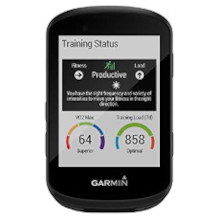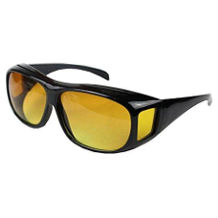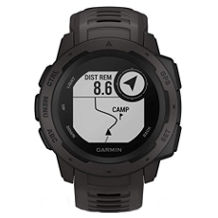Kids walkie-talkie purchasing advice: how to choose the right product
- The most important facts in brief
- Children’s walkie-talkies are radios that are specially designed in terms of design and handling for use by children from the age of four.
- Criteria such as range, multi-channel use and features such as a torch are important in the purchase decision.
- Child-friendly walkie-talkies can motivate children to play outdoors and promote social contacts and communication skills.
- The radiation emitted by children’s walkie-talkies is comparable to that of radios or other radio devices and is therefore harmless.
Children’s walkie-talkies: adventures via radio
In the past, children connected two mugs with a cord – today the mug phone is out of fashion. Instead, the use of smartphones is already playing a role at a young age. With an age-appropriate walkie-talkie, children have an optimal intermediate solution that combines technology and nostalgia. With it, they can talk to each other over a certain distance. Visually, the devices are immediately recognisable as being suitable for children, but technically they have been modelled on the radios for adults. This is exactly what makes them so appealing to many children.
For whom are children’s walkie-talkies suitable?
As a rule, the devices are suitable for children from the age of four. Children’s walkie-talkies are ideal for enriching outdoor play and making outdoor adventures more attractive for the little ones. The communicative and social aspect is also positive. Especially in this age group, it is important for children to learn how to interact with other children. Of course, they can also play with their siblings or parents and often they are certainly happy about the short trip back to their own childhood. However, walkie-talkies are primarily suitable for children of the same or similar age. In addition, more than two walkie-talkies can often be linked to expand the number of players.
What are the characteristics of children’s walkie-talkies?
According to the age group, children’s walkie-talkies should be robustly built and have a flexible antenna as well as simple menu navigation. The main focus is on the safety of the children. Although the general robustness protects the device itself if it falls to the ground, for example, the absence of corners and edges is even more important to minimise the risk of injury. The same applies to the flexible antenna, which gives way when it bumps against a solid object.
Of course, the fun of playing is also important – young children in particular can quickly lose interest if the operation is too complicated. Moreover, there are neither fees nor registration, because the frequency range can be used freely; however, the range of the devices is not only limited, but also lower than that of full-fledged walkie-talkies. Since it is a freely usable frequency range, radio interference may occur. In addition, you have to expect that the small devices have a high battery consumption.
Pro points
- Child-friendly design
- No risk of injury
- Promotes social contacts
- Several devices can be linked
- Toll-free use
Drawbacks
- Usually only short range
- Often high battery consumption
- Radio overlaps possible
How children’s walkie-talkies work
In terms of operation, children’s walkie-talkies do not differ too much from the adult versions. They transmit on the same frequency as other PMR446 devices. The transmit and receive modes are usually controlled by buttons, unless the device has a VOX function. However, this feature is not mandatory for children’s walkie-talkies.
If noise cancellation is integrated, it is normally automatic in products for children. Changeable radio channels simplify use if a channel is already occupied. Walkie-talkies, like televisions and radios, work with radio waves. They convert radio waves so that other devices can pick them up and convert them back into the actual signal. To ensure this, users must set the receiving device to the same wave frequency – i.e. radio on the same channel.
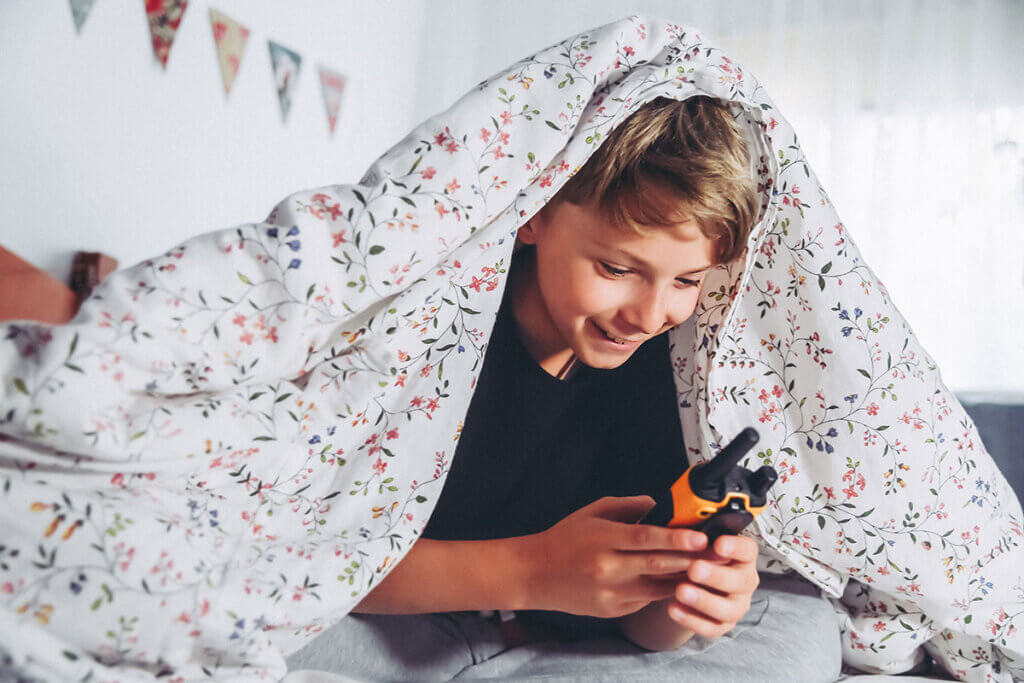
Frequency
Children’s radios operate on a frequency reserved for hobby use, usually in the UHF range between 446.0 and 446.2 megahertz. In this context, interested parties also come across the term “PMR446”. This refers to the so-called “Everyman’s Radio”, a collective term for applications that can be used without a licence.
Regulations in other countries
In Germany, the common “PMR446” walkie-talkies should not be a problem for children, because the use of the frequency is clearly regulated according to paragraph 55 of the Telecommunications Act, TKG for short. This also applies to most European countries, but when going on holiday abroad, parents should still check whether the devices may be used and, if so, on which frequency communication is possible.
Radio channels
Although there are 16 channels, this does not mean that PMR handheld radios use all of them. On average, children have five channels available; particularly high-quality walkie-talkies can switch between eight channels. The more channels available, the less radio interference is a factor. Models that only allow one channel are therefore not recommended. With an integrated coding function, sub-channels can be created so that outsiders have no access. The advantage: the so-called DCS/CTCSS coding protects children from outside listeners. Parents can set the encrypted sub-channels themselves before the children play with the walkie-talkies.
Noise reduction
Noise is part of the nostalgic sense, but it can also be annoying when using children’s walkie-talkies. Since the signals are analogue, noise is unavoidable. However, it can be suppressed with an appropriate function. With children’s walkie-talkies, this is usually done automatically.
For easier operation
Unlike radios for adults, the sensitivity of children’s walkie-talkies cannot usually be set manually. This has the disadvantage that adult users cannot use the range manually. However, the control would be too complicated for children in many cases. Therefore, it is practical that most settings on children’s walkie-talkies are automatic.
VOX mode
The abbreviation VOX stands for “Voice Operated Exchange” and describes a function that parents know from a baby monitor: It is not necessary to press a button to have your own words transmitted by the walkie-talkie. Instead, the device recognises when someone is speaking and automatically switches to transmit mode. This is more of a gimmick that is not part of the standard range of functions.
With very young people, coordination and motor skills play an important role in the learning context, so that technical facilitation does not always seem to make sense. For example, if the children’s walkie-talkie is often worn on the belt to have both hands free when playing, the VOX function can be useful. Some models with VOX mode can also be used in combination with a headset to simplify handling.
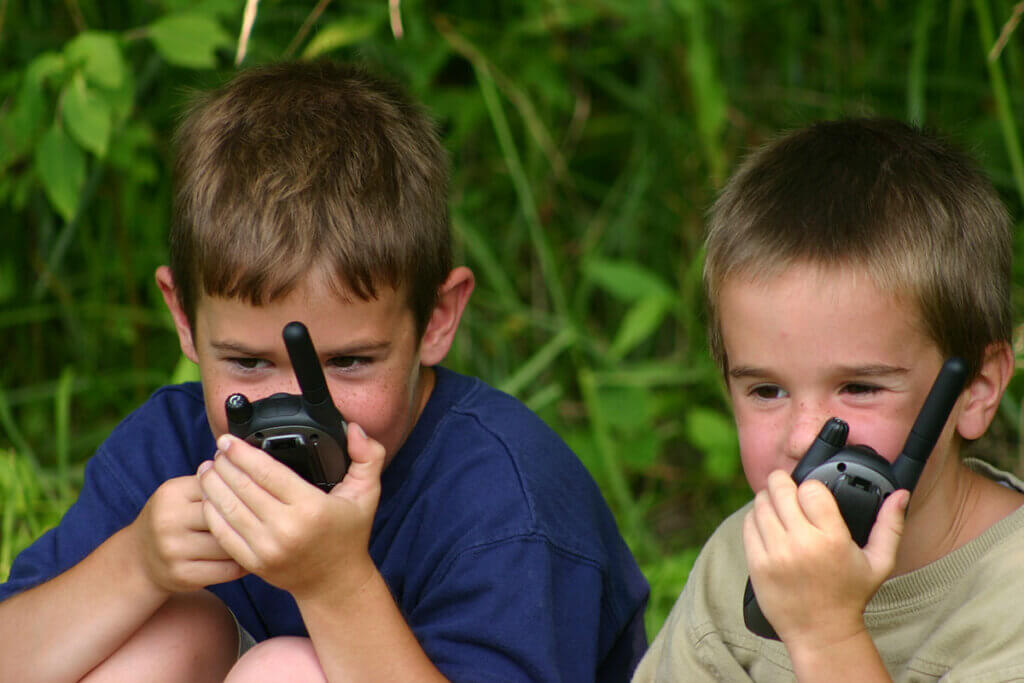
Which purchase criteria are important?
One of the most important aspects in the purchase decision is the range. Since it is a toy for children, usage factors such as the weight and dimensions of the product also come to the fore. A long battery life ensures that children are kept busy for as long as possible. Certain features and functions generally increase the appeal. In addition, the walkie-talkie design should reflect the child’s individuality or preferences.
Range
The range indicates the maximum distance at which the radio works. The range is very large: from two to ten kilometres. Many models can be used at a range of three to four kilometres. In most cases, children’s walkie-talkies with a range of around three kilometres are sufficient. The higher the range, the larger the play radius. However, a small radius is useful to keep an overview of the children’s playing field.

In order to choose a certain range, parents should also know in which environment the walkie-talkies are preferably used, because obstacles such as trees and walls can greatly impair the maximum range. The manufacturer’s specifications are based on optimal conditions, so some compromises are possible.
Radiation harmless
The radiation is comparable to that of a radio, for example, and is considered harmless. Although people who use a walkie-talkie are exposed to a certain amount of radiation, this is also the case in everyday life with other electronic devices such as WLAN routers and smartphones. Parents do not need to worry about this.
Dimensions and weight
Walkie-talkies for children should not be too big and heavy. They must fit in children’s hands and should not be unwieldy even when played with for a long time. On average, walkie-talkies weigh around 100 grams, although there are lighter models weighing around 70 grams and models that weigh over 200 grams. If they are designated children’s walkie-talkies by the manufacturer, the dimensions and weight usually correspond to a suitable format.
Battery life
A large number of children’s walkie-talkies get the necessary energy from AAA batteries, which are located in a compartment on the back. In the meantime, however, there are also battery-operated models. The advantage of such devices is that they are ecologically and financially more valuable because the batteries can be recharged – usually with the help of a charger included in the delivery. In this way, users reduce the amount of waste produced by batteries and save money in the long run. Above all, the environmentally friendly aspect serves as a learning point for children. Rechargeable batteries, i.e. replaceable batteries in AAA format, are an intermediate solution. The running times vary greatly: some rechargeable batteries promise 8 hours of operation apart from stand-by use. With very high-quality batteries, some walkie-talkies even work for up to 16 hours.
Design
Cool, cute, funny, animal, colourful – children’s walkie-talkies are available in various colours and shapes. This makes them stand out visually from the inconspicuously designed walkie-talkies for adults. Well-known logos or film characters are also very popular. The design of the walkie-talkie should match the child’s interest or hobby. Parents know their offspring best and often know exactly what they are most excited about.
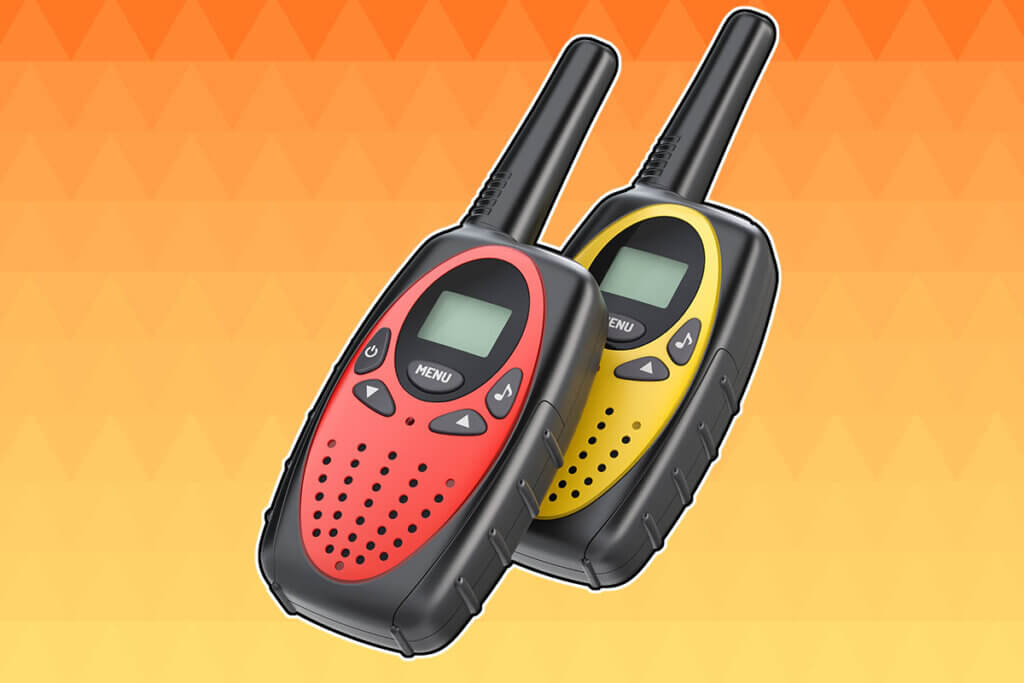
Features and functions
Since the fun of playing is in the foreground, the range of functions is only important in certain aspects of children’s walkie-talkies. Here, it is hardly a matter of optimising or simplifying the sparking with useful add-ons, but rather of providing additional incentives – for example, with features such as a torch, a belt clip, an easy-to-use display or different ring tones.
A torch is a perfect gadget for children, as it makes nighttime adventures in the garden or camping with the family more exciting. An integrated display makes operation easier and is primarily important if the channels of the children’s walkie-talkie are changeable: Without a screen, setting all devices to the same channel is more difficult. Here you have the choice between simple digital displays and illuminated versions that also show the battery level, among other things. A belt clip makes it easy to attach the product to your trousers and ringtones are a fun auditory addition – in some cases children can choose from up to ten tones.
Practical features include an energy-saving function, a key lock and a scan function. If the device is waterproof, the child has all the options. If the walkie-talkie has an energy-saving function, the battery is automatically conserved in certain situations. Some devices activate a power-saving mode when they are not in use for a longer period of time; others consume less energy for shorter distances.
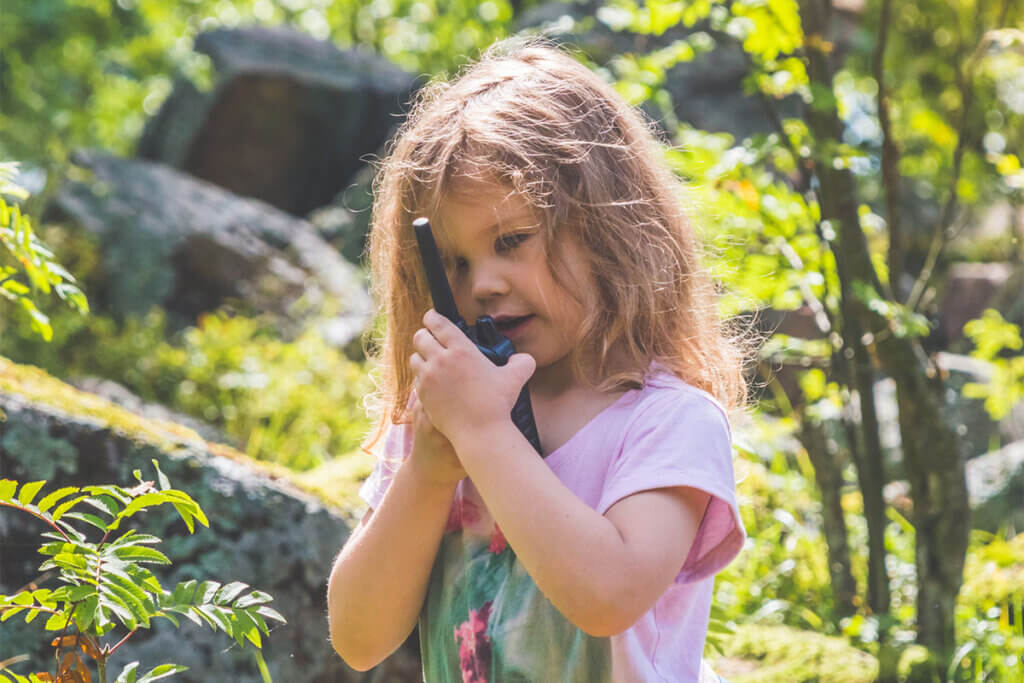
Children romp, run and fall from time to time – so it is all the more important that they do not operate the radio accidentally and, for example, change the channel; a key lock ensures this. With the help of the scan function, users can easily find a free channel. Here, parents should decide whether they want to replace manual searching with automatic channel searching. Certain children’s walkie-talkies are declared waterproof by the manufacturer. Apart from that, they should be splash-proof, because many children especially like to play in the rain and are almost magically attracted to puddles.
Fig. 1: © Fabio Principe / stock.adobe.com | Fig. 2: © sonya etchison / stock.adobe.com | Fig. 3: © nacho roca / stock.adobe.com | Fig. 4: © mipan / stock.adobe.com | Fig. 5: © dmitrypk/ stock.adobe.com

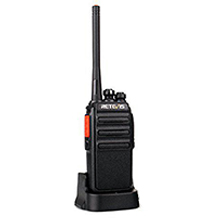
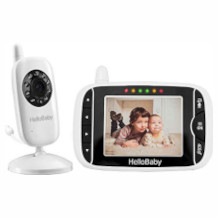

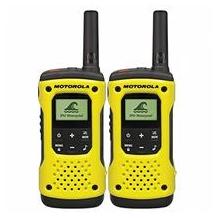

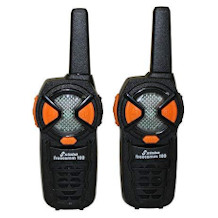
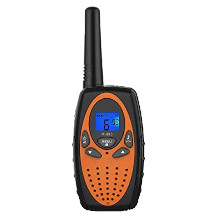
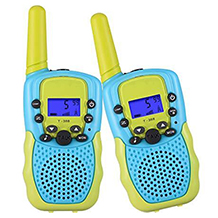
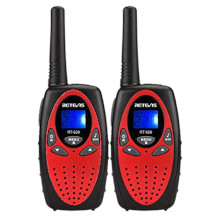
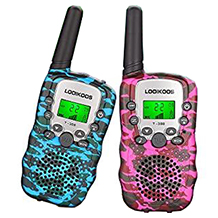
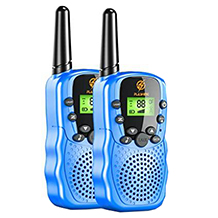
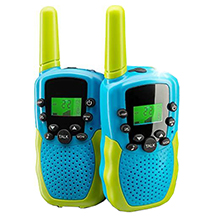

 2,305 reviews
2,305 reviews

